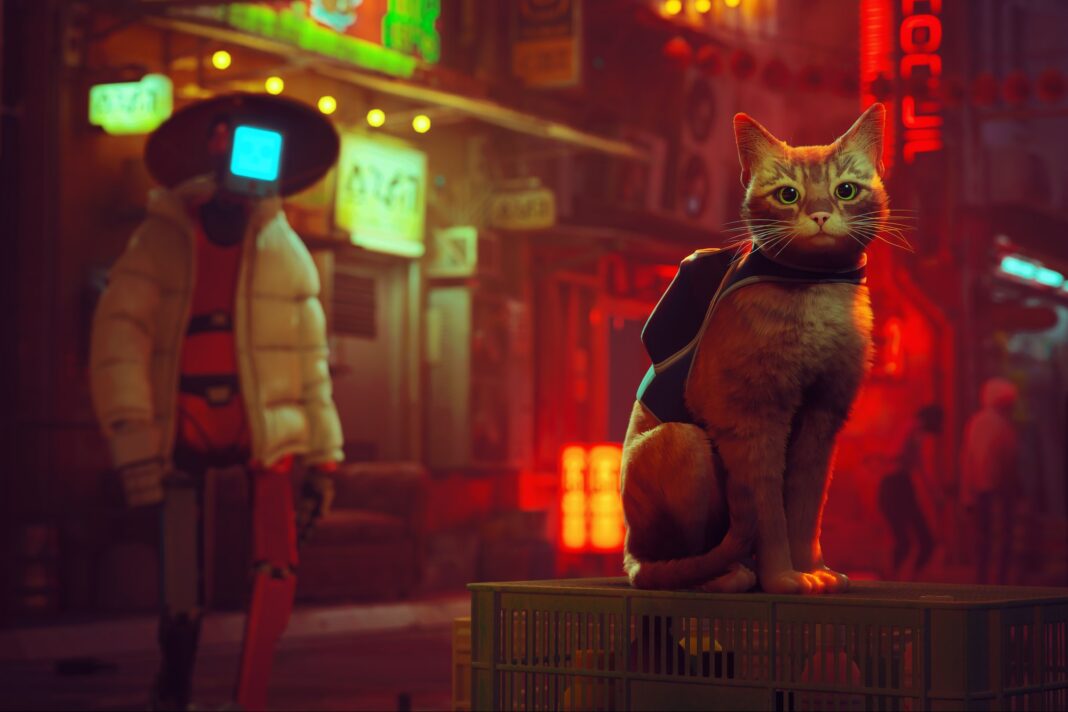In Stray , you play as a cat. For many, this is a mic drop worthy of an instant purchase, and Blue Twelve Studio, the former Ubisoft employees responsible for the game, clearly know this—from the very beginning, Stray taps in shamelessly to the memeable antics of Felis catus . Where do I start? You press O to meow.
You hammer L and R to scratch trees (and furniture). You purr from nooks and lounge in crannies. Interludes see you waltzing on a keyboard, prancing on pianos, and terrorizing board games.
And while Stray ’s cat is just a ginger tabby, not as long or genetically mutated or struggling to breathe as more famous internet cats, it will, just as Untitled Goose Game ’s goose before it, still provide rich fodder for memes. Thanks to a partnership with Travel Cat , there’s even a Stray -themed collection of harnesses and backpacks capable of carrying “25 lbs of cat in its sturdy, well-ventilated chassis. ” There’s been a lot of talk about the cat, and fair enough, it’s the star of the show here.
But I’m going to focus on something else: namely, the seemingly limitless influence of the now-lost Walled City of Kowloon . Stray is set after the apocalypse. Humans are gone, but cats prove hardy as cockroaches.
( Jonathan Franzen wept . ) The game opens on four fur balls avoiding the rain in a vine-wrapped concrete edifice. On your daily strut through the ruins of industrial civilization, you slip down a crevice, into the darkness, landing hard in a moldering sewer.
After nosing around a laboratory you discover a flying drone called B12. This drone will act as the Navi to your mute Link, living in a backpack that looks a lot like the one I just mentioned, which lets you—er, the cat—carry out tasks that require opposable thumbs—like using flashlights and keys—and a concept of language—like translating Robot into American English. The scene is eerily familiar.
In 1993, William Gibson visited Singapore and recoiled at the spick and span dystopia he found there . As he decompressed on his flight back home, he revealed a vain hope: to catch a second glimpse of an ongoing obsession “before the future comes to tear it down. ” This obsession was the Walled City of Kowloon.
He wrote: “Hive of dream. Those mismatched, uncalculated windows. How they seemed to absorb all the frantic activity of Kai Tak airport, sucking in energy like a black hole.
I was ready for something like that. ” The Walled City, when it still stood, loomed on the edge of Kowloon City , then part of British Hong Kong. Controlled by China as a de jure enclave, it became a political pinball: Hong Kong’s British governors hated it; China wouldn’t demolish it.
It was run by five triad gangs, explains James Crawford in an article for Atlas Obscura . There was “no tax, no regulation of businesses, no health or planning systems, no police presence. People could come to Kowloon, and, in official terms, disappear.
” Remarkable productivity—the residents churned out enough fish balls to supply Hong Kong’s wealthy upper classes—mingled with gambling, prostitution, and drugs. Even the rats, writes Crawford, writhed with heroin addiction. The city itself was a cyberpunk dream, a Detroit-style pizza slice of concrete and metal.
The densest city in the world, it contained “350 buildings, almost all between 10 and 14 stories high, occupied by 8,500 premises, 10,700 households, and more than 33,000 residents. ” Residents erected homemade high-rises, “lover’s buildings,” named for the way they leaned against each other. They blocked light from reaching the alleyways below, giving the city its other name, Hak Nam—the City of Darkness.
China demolished the Walled City in 1994, a year after Gibson wrote his article. In this dark labyrinth, he perceived a world outside of corporate colonization, an anarchy he would render in his fiction. The city’s influence has permeated across media into some of our most significant popular culture, from the Ghost in the Shell anime, to the Bourne series, to Christopher Nolan’s Batman .
Games are no different: Stray is only the latest homage. Players raided the city in Call of Duty: Black Ops back in 2010. Stray ’s take on the city is obviously bereft of humans, and there’s a familiar cyberpunk story about a malicious corporation bubbling away in the background.
Luckily, you play as a cat, a schtick that elevates the game’s homage. Gameplay breaks down into puzzles—stepping into a can and rolling it to create a good vantage point for a leap—and hair-raising moments fleeing enemies. An X appears over ledges you can jump to, an on-the-rails kind of control that is closer to point-and-click adventure than platformer.
In an interview with VG247 , Stray ’s developers pointed out that missing a jump might make sense for a mere man like Mario, but less so for a cat, the ultimate platformer. Soon you get the hang of it, and start to zip through the murk, along the alleyways, tunnels, pipes, stairwells, corridors, cast-iron grates and air-con units, even gliding over the city in buckets on strings. We have reached peak cyberpunk, for sure: The setting shed its political power a long time ago .
But away from that kind of interpretation, you can’t deny the pleasure that comes from visiting somewhere you always wanted to, in a way you never dreamed you could. At one point, a robot in a flamingo dress pulls open a blind to reveal a radio tower you must climb and fix. It stands against an array of stars, lights on the city’s hermetic roof blocking out all sunlight—a city of darkness.
.
From: wired
URL: https://www.wired.com/story/stray-design-walled-city-kowloon/



